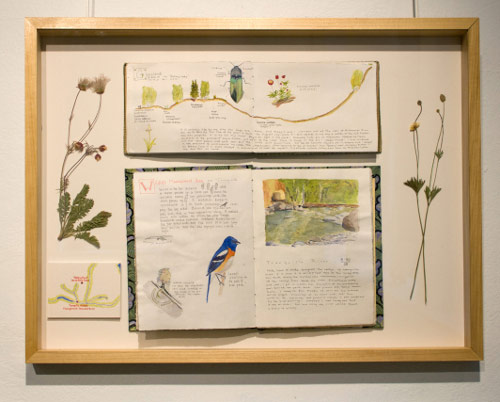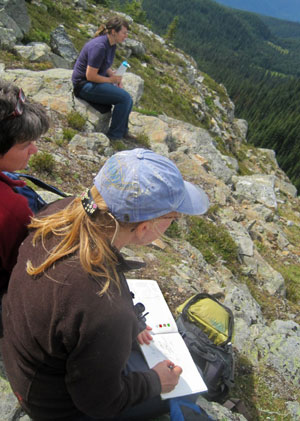
Hill and River, by Lyn Baldwin. Pen and watercolour with accompanying artifacts, from “Not Just a Snapshot: The Thompson Drainage through Field Journal Art”.
Art and science intersect in the work of plant ecologist Dr. Lyn Baldwin. In “Not Just a Snapshot: The Thompson Drainage through Field Journal Art”, an exhibit at the Kamloops Art Council Main Gallery January 9 to February 1, the TRU Biological Sciences professor reveals the natural history of the region drained by the Thompson rivers, captured through field journal drawings in pen and watercolour, and hand-written observations.
In an interview on CBC Radio’s North by Northwest on January 18, Baldwin talks about the combination of scientific enquiry and artistic expression represented by her field journalling. “Attending to the natural world occurs through both images and words, and it is the synergy that happens between them on a full page spread that really seems to best capture that moment.”
Listen to the North by Northwest interview (see Featured Audio, Jan 18).
Baldwin encourages her botany and ecology students to do field journalling—to sketch their observations in the field, a practice Baldwin first learned while studying natural history—so they can reflect more deeply on their findings. She emphasizes the importance of natural history in enhancing student engagement with the environment they study, and since 2005 she has led ecology field schools at TRU’s research centre at Wells Gray Provincial Park to give students an opportunity to connect what they learn in the classroom to hands-on observation. The ecology of Wells Gray has inspired many volumes of her own journals.
The artwork exhibited in “Not Just a Snapshot” represent much of her field journalling from the past year, notes Baldwin on her university blog, The Viridian Life. Among her drawings and watercolours, handwritten annotations highlight her botanical observations, and the musings that make up another facet of Baldwin’s interdisciplinary working life—creative non-fiction.
See selected work from the exhibit and more on Baldwin’s The Viridian Life.

Baldwin journals with her students during her Field School in Terrestrial Ecology in Wells Gray Provincial Park.
From a gallery description of the show at the Kamloops Art Council:
“Natural history field journals, with their easy confluence of art and science, promote a multi-layered conversation with the land. … Too often overlooked, the Thompson Drainage runs rich with the stories of a living, breathing world. In this exhibit, field journal art documents and celebrates the natural history we can find just beyond our backyards.”
Baldwin says the show has been well received so far. “The opening was crowded beyond my wildest imagination and I think this speaks to how strongly literature of the land, captured in images and text, can seduce us all.”
The show concludes at the Kamloops Art Council Main Gallery on February 1.

